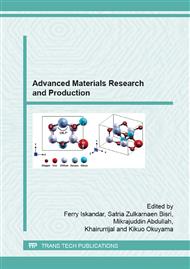p.71
p.76
p.80
p.85
p.89
p.94
p.98
p.102
p.106
Formation of Porous Anodic Alumina from Impure Aluminum Foil in Inorganic Acids
Abstract:
The morphology of porous anodic alumina (PAA) formed by anodizing in inorganic electrolytes is reported. An impure aluminum was anodized in sulfuric acid, phosphoric acid and chromic acid at room temperature with a constant applied potential 2 – 30 V. The formation of porous anodic alumina was carried out by one and two steps anodization. It is clearly noted that anodizing impure aluminum at room temperature provide higher kinetic of oxide dissolution compared to oxide growth. Two steps anodizing aluminum in sulfate electrolyte always resulted in random porous alumina, while phosphate electrolyte provided strong anodization producing irregular porous alumina with average diameter of 61.6 nm. Two steps anodizing aluminum in chromate electrolyte produce better pore ordering with relatively large size pore distributions. The average pore diameter of alumina increases linearly with applied voltage, with proportionality factor lp 0.83 nmV-1. Annealing the sample increased the interpore distance, removed stresses providing lower activation energy for pore formation.
Info:
Periodical:
Pages:
89-93
Citation:
Online since:
July 2015
Authors:
Keywords:
Price:
Сopyright:
© 2015 Trans Tech Publications Ltd. All Rights Reserved
Share:
Citation:


